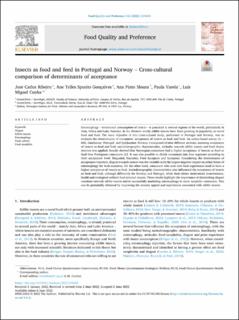| dc.contributor.author | Ribeiro, Jose Carlos | |
| dc.contributor.author | Gonçalves, Ane Telles Sposito | |
| dc.contributor.author | Moura, Ana Pinto | |
| dc.contributor.author | Varela, Paula | |
| dc.contributor.author | Cunha, Luís Miguel | |
| dc.date.accessioned | 2022-11-30T12:55:34Z | |
| dc.date.available | 2022-11-30T12:55:34Z | |
| dc.date.created | 2022-06-28T10:01:25Z | |
| dc.date.issued | 2022 | |
| dc.identifier.issn | 0950-3293 | |
| dc.identifier.uri | https://hdl.handle.net/11250/3035076 | |
| dc.description.abstract | Entomophagy – intentional consumption of insects – is practiced in several regions of the world, particularly in Asia, Africa and Latin America. In the Western world, edible insects have been growing in popularity as novel food and feed. The main objective of this cross-cultural study, performed in Portugal and Norway, was to evaluate the determinants of consumers’ acceptance of insects as food and feed. An online-based survey (n = 666, LimeSurvey -Portugal- and EyeQuestion -Norway-) composed of nine different sections, assessing acceptance of insects as food and feed, sociodemographic characteristics, attitudes towards edible insects and food choice motives was applied. Results showed that Norwegian consumers had a higher acceptance of insects as food or feed than Portuguese consumers did. It was also possible to divide consumers into four segments according to their acceptance level: Disgusted, Rejecters, Feed Acceptors and Acceptors. Considering the determinants of acceptance/rejection, disgust towards insects was the variable with the largest negative impact on either forms of entomophagy for both countries. On the other hand, consumers who seek new food experiences tend to have a higher acceptance of insects as food. Sociodemographic characteristics also influenced the acceptance of insects as food and feed, although differently for Norway and Portugal, while food choice motivations (convenience, health and ecological welfare) had minimal impact. These results highlight the importance of diminishing disgust reactions towards edible insects and to successfully marketing entomophagy to more neophilic consumers. This can be potentially obtained by improving the sensory appeal and experiences associated with edible insects. | |
| dc.description.abstract | Insects as food and feed in Portugal and Norway – Cross-cultural comparison of determinants of acceptance | |
| dc.language.iso | eng | |
| dc.title | Insects as food and feed in Portugal and Norway – Cross-cultural comparison of determinants of acceptance | |
| dc.title.alternative | Insects as food and feed in Portugal and Norway – Cross-cultural comparison of determinants of acceptance | |
| dc.type | Peer reviewed | |
| dc.type | Journal article | |
| dc.description.version | publishedVersion | |
| dc.source.volume | 102 | |
| dc.source.journal | Food Quality and Preference | |
| dc.identifier.doi | 10.1016/j.foodqual.2022.104650 | |
| dc.identifier.cristin | 2035642 | |
| dc.relation.project | Nofima AS: 202103 | |
| dc.relation.project | Norges forskningsråd: 314318 | |
| cristin.ispublished | true | |
| cristin.fulltext | original | |
| cristin.qualitycode | 1 | |
